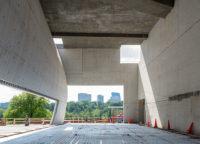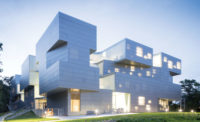In 2012, when the trustees of the John F. Kennedy Center for the Performing Arts in Washington were selecting an architect to expand the facility, they knew they had an unusual challenge. The problem was not that the imposing structure, completed in 1971 by Edward Durell Stone, was so good that any change could damage its aesthetic. On the contrary, it has long been considered an overblown example of monumental modernism in its dated, classicizing symmetry and white marble cladding. Ada Louise Huxtable’s epigrammatic conclusion to her New York Times critique seemed to be its epitaph: “It is a cross between a concrete candy box and marble sarcophagus in which the art of architecture lies buried.”
Additional Content:
Jump to credits & specifications
Yet, decades later, the memorial-cum-performing-arts venue lived on, though in need of more rehearsal space, classrooms, and event areas. The problem was how to come up with an expansion that enlivened the whole and avoided the leaden demeanor of the original. (Previously, the board had deemed a proposal by Rafael Viñoly in 2003 to be too ambitious, although it had tried to relate the center on its promontory along the Potomac River to the rest of the city—a concern that didn’t go away.)
On this recent foray, the center selected Steven Holl Architects (SHA) in an invited competition over runners-up Diller Scofidio + Renfro, Richard Meier & Partners, and Pei Cobb Freed, favoring SHA’s emphasis on making the most of the landscape and connecting the complex to the river.
In providing a new 72,000-square-foot, $250 million annex, which opened September 7, SHA worked with associate architect BNIM in adopting a design approach that embraces opposites. As a counterpoint to the single big box perched above the Potomac, Holl and his team created three separate, abstract forms, partially embedded in the earth and connected to each other underground. Rather than the symmetrical and hierarchical organization of Stone’s opera house, concert hall, and a theater, SHA has designed a meandering series of flexible spaces. The Welcome Pavilion, closest to the Kennedy Center, holds the entrance lobby, leading to rehearsal spaces, classrooms, and an auditorium. A second pavilion contains a café, and the third is an event space, defined by a dramatic concave wall.
With Holl, what happens in section arguably is more important than the plan. Walls may be curved or flat, tilted or straight; ceilings may drop and rise, or be topped by a skylight; and stairs, balconies, and bridges overlook spaces below to give visual access to various activities. As you thread through the different labyrinthine levels here, you are aware of optical, haptic, and kinesthetic sensations fused into a shifting perceptual experience.
If the overall design concept appears familiar, it should: Holl’s addition to the Nelson-Atkins Museum of Art in Kansas City involved a series of irregularly shaped polyhedral forms embedded in the hillside next to the classical pile designed in 1933 by Wight and Wight. The success of SHA’s Nelson-Atkins addition owes much to its above-ground structures’ having walls of channel-glass planks, separated from laminated glass by a 3-foot space for fluorescent tubes. The shimmering opalescent effect by day (the sun glinting off the surface) and night (from the inner glow of lighting) made the architecture, nestled within greenery, smashing. Inside, the sequence of new galleries flowed with a strong sense of continuity as the spaces gradually dropped down the hill.
At the Kennedy Center annex—which is called the Reach, a somewhat New Agey term expressing the center’s ambitions to extend to younger audiences—the construction is largely poured-in-place concrete, alternating with glass expanses. White cement and sand, along with recycled furnace slag, is mixed with titanium so that the tone approaches the gleaming whiteness of Stone’s Carrara-marble hall.
The concrete walls show the imprint of 4-inch tongue-and-groove Douglas fir boards that lined the CNC-milled plywood forms. The pour is impeccable. You notice this especially where walls arc upward. But material’s surface is not the only noticeable feature: “The voids between the pavilions are as important as the solid shapes,” says SHA senior partner Chris McVoy. “The building profiles cup the spaces and frame the views.”
The glazing in the pavilions is either transparent or translucent—etched on the outer surface, with a white film laminated between the double lites. Linear LED tubes at the tops give these milky expanses a luminous glow by dark.
The materials inside are striking as well. Project architect Garrick Ambrose helped develop a crinkle concrete for acoustical purposes in the auditorium (which seats 144) and in three studios. To accomplish this, the team folded and crumpled a 4-by-10-foot aluminum sheet, which became the template for rubber molds used for casting the concrete on-site. The result is a 3-inch-deep random relief of exposed concrete that breaks up sound—and appeals to the sense of touch.
Other technical flourishes abound. To achieve a long span of 65 feet for the ceiling in Studio K, which is used for opera rehearsals, SHA, working with Silman engineers, developed a poured-in-place concrete slab post-tensioned with cables. Its sawtooth profile and bubble deck lightens its dead weight.
In certain places on the exterior, where the pavilion walls curve up, the architects created what they call “sedum swoops” to help meld the three pavilions with the earth. These torqued geometrical planes, turned into curved, vertical green swaths, are supported on a honeycomb geogrid with tensioned cables and computerized irrigation. Elsewhere, 60 geothermal wells, installed beneath the gardens, help heat and cool the annex. Other measures such as radiant floors will cut the energy use and help the complex qualify for LEED Gold certification.
In designing the 130,000 square feet of lawns, gardens, walking paths, and a grove of 35 ginkgo trees (a tribute to the 35th President), Holl and landscape architect Edmund Hollander sought to create an environment that would attract the public on bikes or on foot. SHA also included a pedestrian bridge—a steel structure with spans of 84 feet between the piers—to extend over the Rock Creek Parkway to the Potomac’s edge.
Clustered in the landscape, the quiet, idiosyncratic pavilions appear to be enlarged sculptures. On a sunny day, the concrete and titanium white walls almost glisten. But the sun is key to the effect: the elevations facing north appear flat and dull. Unfortunately, this is the side you first see when approaching the Kennedy Center’s main entrance. From this vantage point, the ancillary structures are unprepossessing—and the monotonous large, flat bluestone terrace, covering the underground parking between the old and the new buildings, only emphasizes the desultory aspect. Granted, the terrace could be enlivened by events and performances, and one wall of a pavilion facing north is to be used for simulcast projections. But the whole lacks the luminosity and glinting quality of those channel- glass pavilions at the Nelson-Atkins, not to mention the internal consistency of movement in those more interconnected galleries.
So while the Kennedy Center addition achieves a distinct and strong identity through a design approach similar to the Kansas City museum, it misses the power of the 2007 predecessor. But it does avoid the moribund aspect of Stone’s center, and offers a different kind sculptural park to the community. The new addition may not be perfect, but it cannot be accused of burying the art of architecture.
Time-Lapse Courtesy of Work Zone Cam
CreditsArchitect: Steven Holl Architects 450 West 31st Street, 11th Floor New York, NY 10001 (212) 629-7262
Personnel in architect's firm who should receive special credit: Steven Holl (design architect, principal, FAIA) Chris McVoy (senior partner in charge ) Garrick Ambrose (senior associate in charge, project architect) Magdalena I. Naydekova (assistant project architect ) Bell Ying Yi Cai, Kimberly Chew, J. Leehong Kim, Martin Kropac, Elise Riley, Yun Shi, Dominik Sigg, Alfonso Simelio, JongSeo Lee (project team)
Associate architect(s): BNIM Architects
Engineers: Structural Engineer: Silman Mechanical Engineer: ARUP Civil Engineer: Langan Engineering & Environmental Services Climate Engineer: Transsolar
Consultants: Project Manager/Owner’s Representative: Paratus Group Lighting: L’Observatoire International Cost Estimator: Stuart-Lynn Company Code Consultant: Protection Engineering Group Façade Consultant: Thornton Tomasetti Landscape Architect: Edmund Hollander Design Food Service Consultant: JGL Food Service Consultants Regulatory Consultant: Stantec Acoustic/AV/IT/Security Consultant: Harvey Marshall Berling Associates Vertical Transportation Consultant: Vertran Concrete Consultant: Reg Hough Aossciates Traffic and Parking Consultants: Gorove Slade Associates Pre-Construction Manager: James G. Davis Construction
General contractor: The Whiting-Turner Contracting Company
Photographer: Richard Barnes |
SpecificationsStructural System Structural Void Slab : Cobiax
Exterior Cladding Metal/glass curtain wall: Gartner / Permasteelisa Group
Windows Metal frame: Gartner / Permasteelisa Group
Glazing Glass: Guardian Skylights: Gartner / Permasteelisa Group
Doors Entrances: Jansen / Ellison Bronze Metal doors: Blumcraft Sliding doors: Sky-Frame
Interior Finishes Acoustical ceilings: Baswaphon acoustical plaster / Textum by Armstrong Paints and stains: Keim Mineral Coatings / Sherman Williams Terrazzo Ground Concrete: Cuviello Concrete and Terrazzo Polishing
Furnishings Reception furniture: Custom desk designed by Steven Holl Architects Fixed seating: Hamari Odeon
Lighting Dimming system or other lighting controls: Lutron |


















